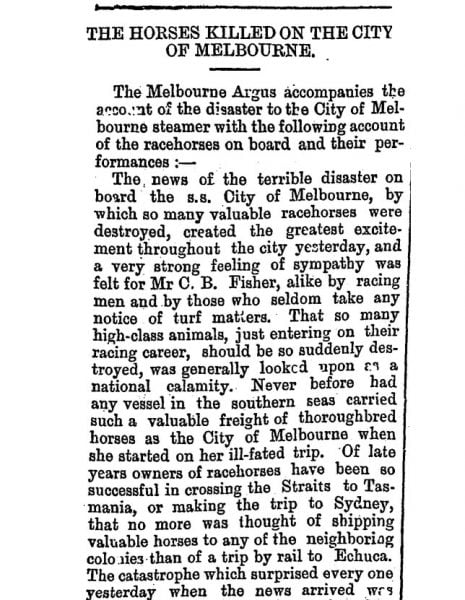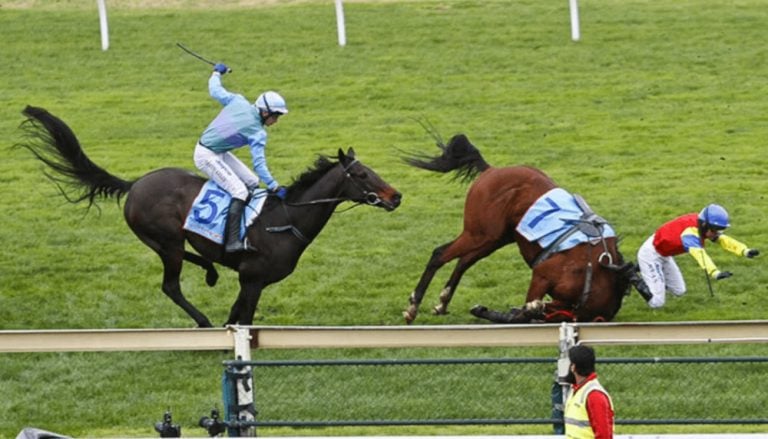Oh, the Melbourne Cup. The race that stops a nation.
Nothing beats the cracking of whips in the crisp, cool air across the fine skin of noble horses, their nerve-endings responding gallantly and scientifically to the constant, violent abuse.
The horses’ young, underdeveloped frames racked with tiny stress fractures and debilitating injuries that will ensure a short, painful life of servitude.
The loving trainers, seeing the horses as dollar-signs: both when they earn millions, and later when they are disposed of; the cost of keeping them too prohibitively expensive to bother with.
Oh, the atmosphere though. The party!
The yells of the crowd spooking the fine nags, drunken sloppy behaviour in the stands in the dappled afternoon, families torn apart by the gambling addictions that fund the entire ‘sport’, the promise of a live assassination should a horse fall and maintain injuries deemed too annoying for owners and trainers to deal with the rehabilitation of.
Oh, the Melbourne Cup!
Here are some of the highlight from the past 150+ glorious years of cup fever. Enjoy!
–
1861:
The very first Melbourne Cup was held in 1861. Three horses fell during the race, and two had to be put down. It is assumed the methods of slaughter in 1861 were less-than-kind.
1876:
A ship carrying thirteen racehorses sailed from Sydney to Melbourne for the big race, despite savage weather conditions making this an unwise trip. Still, money talks, and eleven of the thirteen horses – including Nemisis, the favourite – drowned during the doomed voyage.
1930:
Someone attempts to murder Phar Lap, by shooting bullets at the horse’s body. Luckily, Phar Lap survived the shooting to be whipped another day.
“It is not unusual for a hot favourite for an important race to receive ill-treatment at the hands of miscreants apparently in the employ of some person or persons who would suffer heavy financial loss in the event of the favourite proving successful”, said police at the time.
Ten of them were employed to guard the horse until the race.
1938:

Mrs. A. McDonald becomes the first woman trainer to win the Cup. Luckily for her feminine modesty at the time, mere women weren’t allowed to register as horse trainers in Australia, and so her husband – as the officially registered trainer – received all the glory. Phew!
1979:
Melbourne Cup favourite Dulcify fractures his pelvis midway through the race and is unceremoniously killed.
1998:
Three Crowns breaks down on the final straight and shatters his leg. He is killed as the winning trainer and jockey celebrates metres away.
Check out a memorable ‘highlight’ of the 1998 Melbourne Cup:
2005:
University of Melbourne conducted and published a breakthrough study that found the mere physical exertion of horse racing leads “a large proportion of horses to bleed into their lungs and windpipe — called Exercise-Induced Pulmonary Haemorrhage.”
The study found that 50% of race horses “had blood in the windpipe”, and 90% “had blood deeper in the lungs.” The sport of kings.
2013:
French race horse Verema snaps its leg halfway through the race, and is killed. No mention is made of this during Channel 7’s broadcast, with the focus squarely on celebrity fashion.
2014:
Admire Rakti was the Cup favourite, despite having to lug around the heaviest weight seen in the race since 1975. He died of heart failure directly after the race.
At least he finished though. Race horse Araldo broke his leg after being spooked by a member of the crowd waving a flag, and was killed on the track, in front of thousands of kids. At least they put the sheet up.
Check out a memorable ‘highlight’ of the 2014 Melbourne Cup:
2015:
Ahead of the race that stops a nation, it is revealed that 127 horses died on Australian race tracks during the previous twelve months. That’s over ten a month, with thousands more being injured, then quietly murdered. The number has increased since, with 137 killed between August 1, 2016 and July 31, 2017.
The Coalition for the Protection of Racehorses said during this most recent period, an average of one horse died on Australian racetracks every 2.6 days, “most commonly from catastrophic front limb injury.”
The actual death figures are estimated to be far greater than this though. After all, these are only the deaths we are privy to.
“Many horses will sustain injuries and then simply disappear … for most of these horses, our research has shown, that they end up being slaughtered,” CPR campaign director Elio Celotto told AAP.
“Between 12,000 to 15,000 racehorses exit the racing industry every year … most of them will be sent straight to the slaughterhouse.”
Also 2015:
Red Cadeaux was always the bridesmaid, never the bride, placing second place in three Cups. His big moment came in 2015; he still came second, but suffered a fetlock injury – which isn’t even a fracture. Nevertheless, he was shot and killed two weeks later.
2019:
Who fucking knows. Don’t support the Melbourne Cup. Read more here.


































